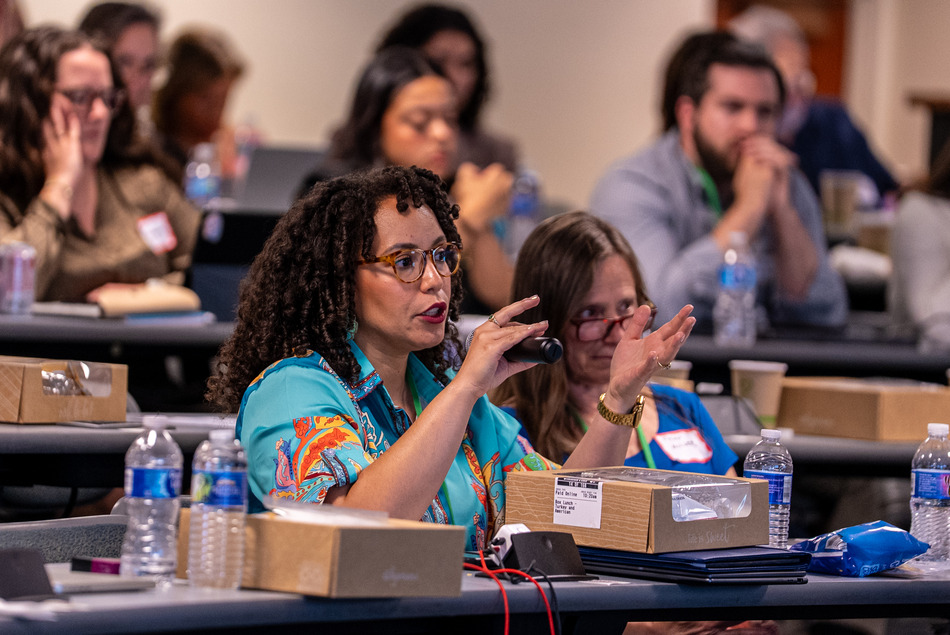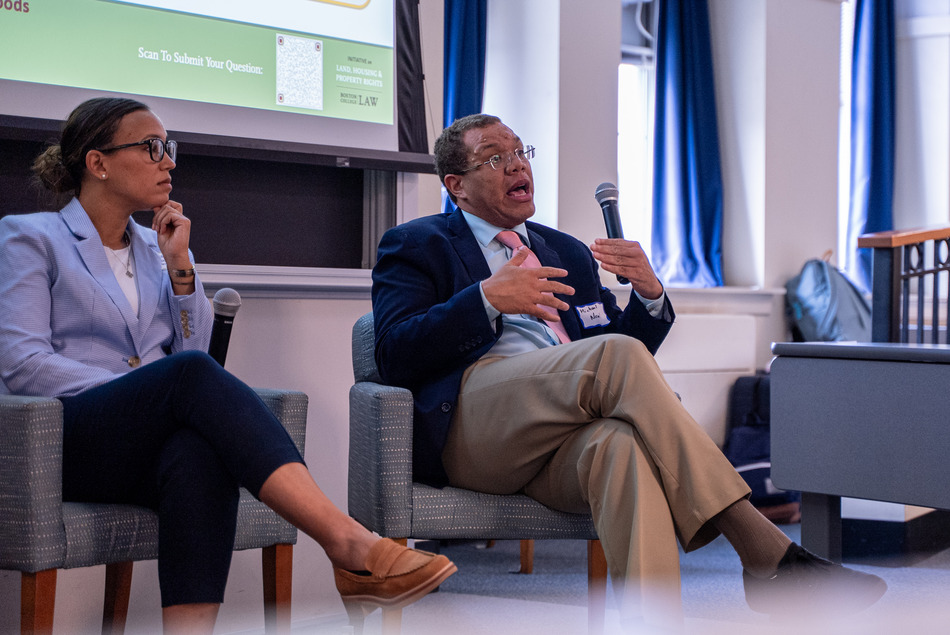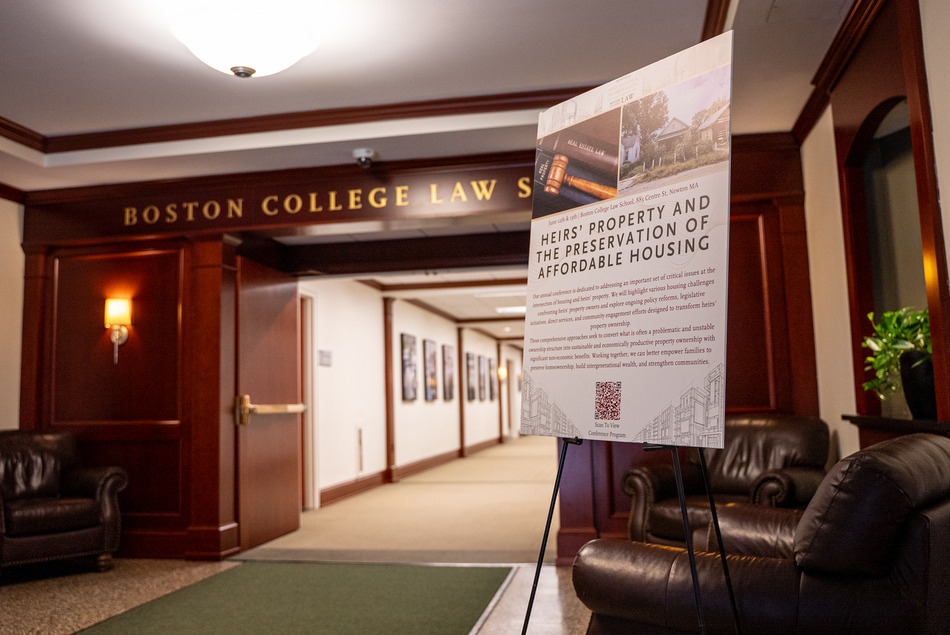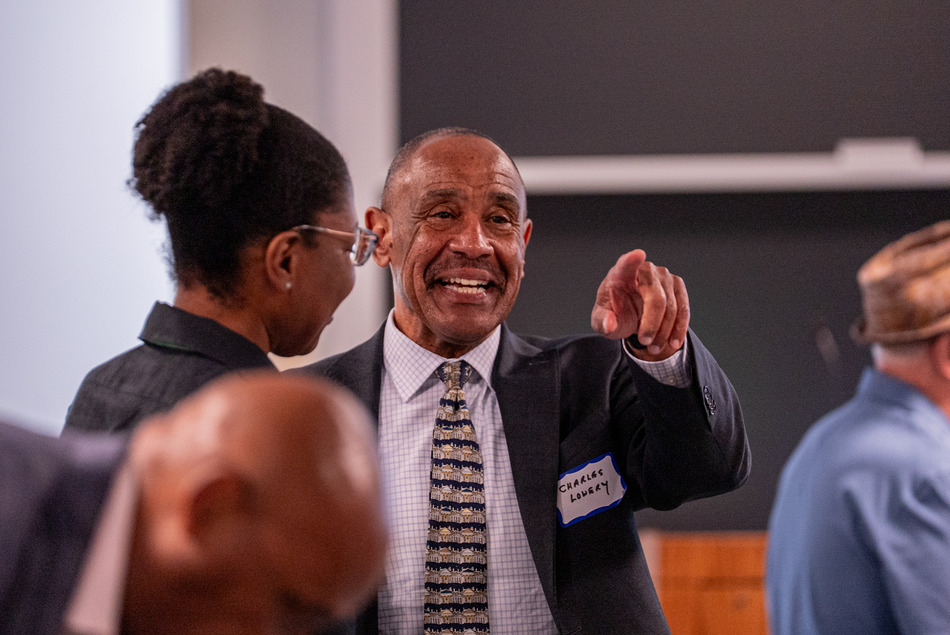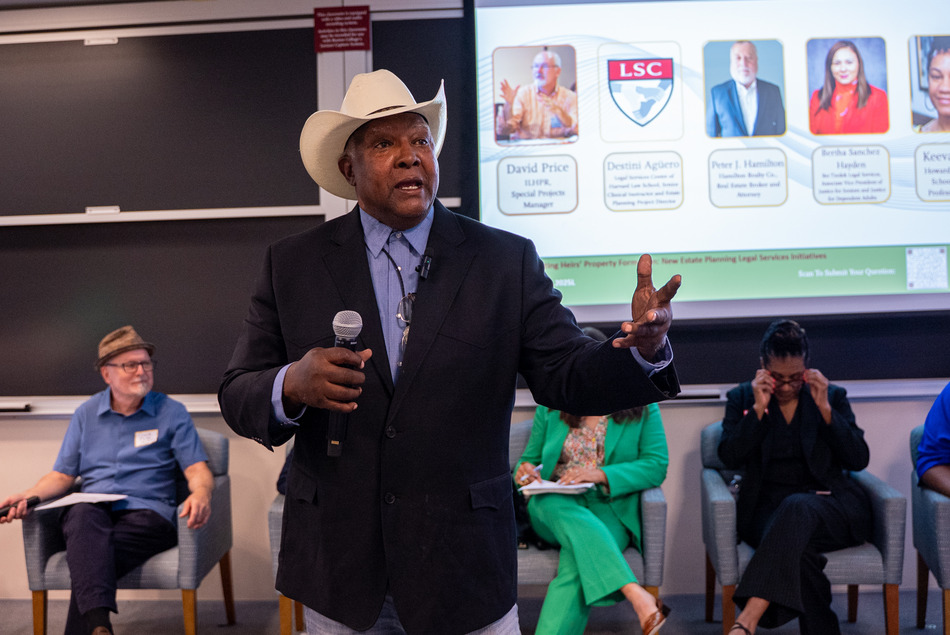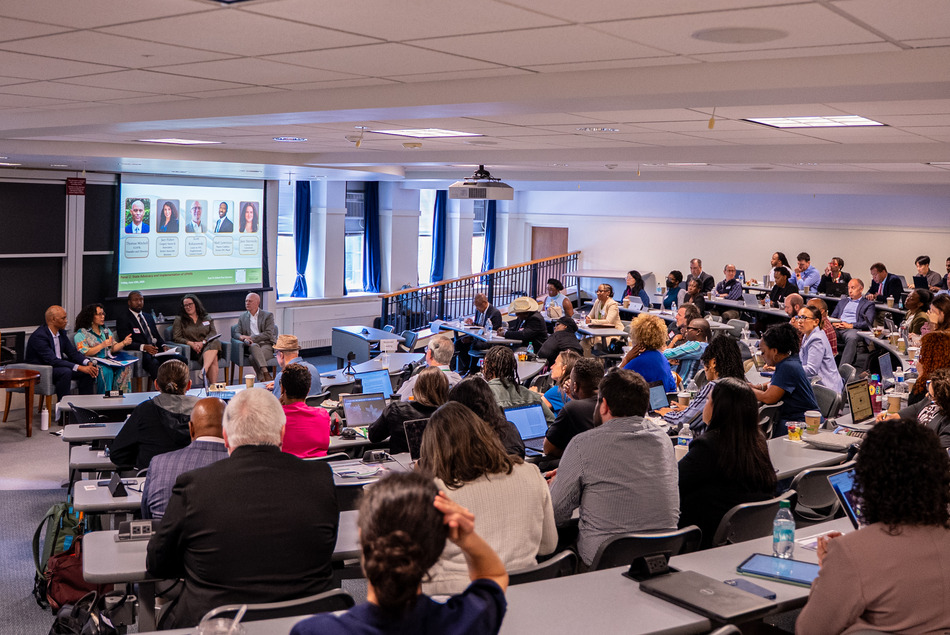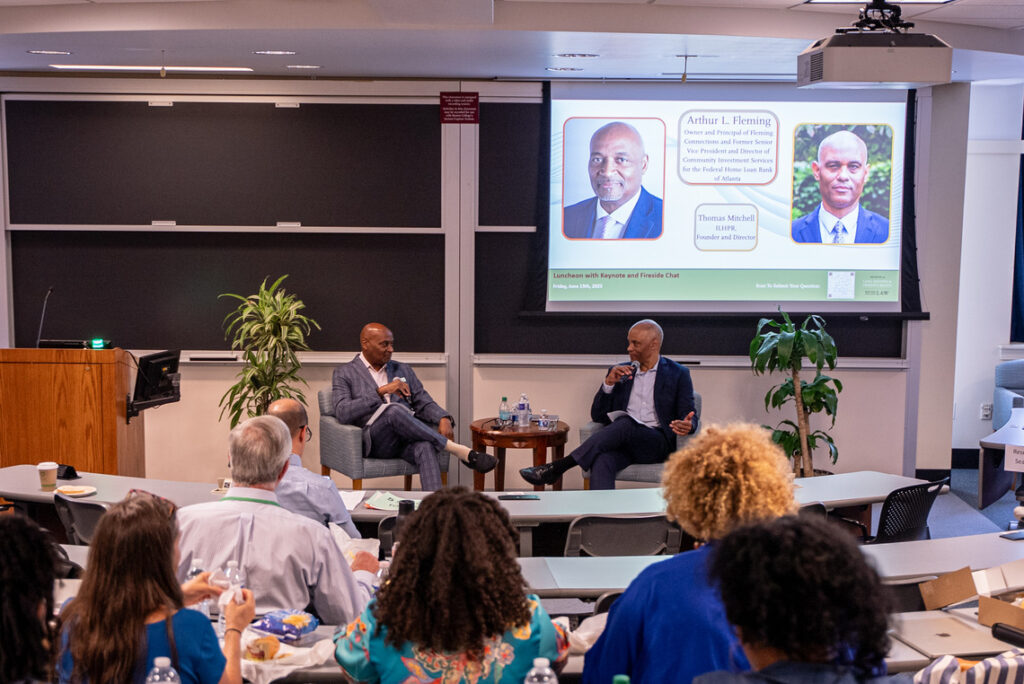Boston College Law School’s Initiative on Land, Housing, & Property Rights (ILHPR) convened over 120 scholars, policymakers, and practitioners from twenty-five states, the District of Columbia, and Puerto Rico at BC Law for its third annual national conference on June 12-13. In addition to the in-person attendees, more than 300 people participated remotely by Zoom. The ILHPR, founded and directed by Professor Thomas W. Mitchell, Robert S. Drinan S.J. Endowed Chair at BC Law, addressed the theme of “Heirs’ Property and the Preservation of Affordable Housing” with this year’s gathering.
The issue of the loss of land and homes has affected people of color disproportionately in the US, where historic patterns of discrimination and exploitation by private and public actors have separated them from their lands and homes, oftentimes with violence and trickery, depriving them of a vital source of intergenerational wealth and contributing significantly to the racial wealth gap in the US.
Professor Mitchell noted in his opening remarks that the homeownership gap between Black and white people is actually larger now than it was in the 1960s, when the country was still in the grips of Jim Crow policies. Rachel Loischild, who presented her Heirs’ Property Photo Project to open the conference, also shared a statistic from a 2022 study—a study for which Professor Mitchell is a co-author—that the compounded value of the Black land loss from 1920 to 1997 was roughly $326 billion. Though the issue of real property loss is certainly not exclusive to Black people in the US, they are, and have been, disproportionately deprived of this fundamental source of economic security and emotional attachment throughout the country’s history.
The conference explored policy, law reform, direct services, and community engagement work that is being done to transform heirs’ property ownership from a tangled, highly unstable form of ownership into one that can be sustainable and productive.
It is against this backdrop that this year’s conference was dedicated to addressing critical issues at the intersection of housing and heirs’ property. Heirs’ property owners often face various housing-related challenges. The conference explored policy, law reform, direct services, and community engagement work that is being done to transform heirs’ property ownership from a tangled, highly unstable form of ownership into one that can be sustainable and productive, both economically and more holistically.
A key panel on Friday focused on the Uniform Partition of Heirs Property Act (UPHPA), a model state statute for which Mitchell is the principal drafter, and its progress as it is adopted into law by more and more states across the country. As of the date of the conference, the UPHPA has been adopted by twenty-five states and other jurisdictions, including seven of the largest ten US states, covering more than two-thirds of the nation’s population. The New Jersey Senate and Assembly recently passed UPHPA bills with no legislator opposing the bills, and the UPHPA will become law there by July 6 unless Governor Murphy vetoes the bill, which is unlikely. In 2025, several other states have introduced legislation to enact the UPHPA, including Massachusetts, Pennsylvania, Rhode Island, and more.
Panelist Jane Sternecky, legislative counsel for the Uniform Law Commission, works on enacting legislation across the country, including the UPHPA. She shared that Mitchell has played a key role in advocating for the UPHPA in states throughout the country.
Professor Thomas Mitchell, principal drafter of the Uniform Partition of Heirs Property Act, noted that states adopting the act are split almost evenly between “red” and “blue” states, a rarity in these times.
For example, she noted that Mitchell headed to Harrisburg in early June with a stack of first-year Property final exams to grade, to be able to present to a number of Pennsylvania legislators and educate them on the UPHPA ahead of their votes on the bill. The many legislators Mitchell met with included the House majority and minority leaders. Mitchell also noted that states adopting the UPHPA are split almost evenly between “red” and “blue” states, a rarity in these times.
Mitchell gave a brief overview of the UPHPA and how it addresses the issues raised by heirs’ property. The three pillars of it include: 1) buyout/right of refusal provisions for co-tenants, which protect against those who own minority interests from forcing a sale of the property, often at below-market rates; 2) requiring courts to consider a range of economic and non-economic considerations when a court decides whether to order the physical division of a property or to order a forced sale of it with the goal of reducing the prevalence of court-ordered forced sales of heirs’ property; 3) and reworking the auction sales procedure for properties a court orders to be sold. Improvements to the auction sales procedure will substantially increase the chances that the sales price will reflect a property’s fair market value instead of the “fire sale” prices many partition sales yield, this change significantly helping to protect family and generational wealth.
Jacy Fisher, senior associate attorney with Gregory Varner & Associates in Alabama who works primarily in rural settings, shared success stories from Alabama. They demonstrate that the UPHPA is working well and as intended, enabling families to retain their properties and generational wealth. She referenced her cases in which families have been able to exercise the UPHPA’s buyout provision when other co-owners wanted the property in question sold. This resulted in these families being able to retain ownership of their property. She also referenced cases in which she was able to use the UPHPA to persuade courts to order the physical division of the property when her clients did not want the entire property sold due to their deep attachments to the land.
Scott Kohanowski, general counsel for the Center for NYC Neighborhoods, discussed how UPHPA implementation in New York City, where partitions of heirs’ property such as a brownstone are much less feasible, have improved conditions. The city built upon the idea put forward previously by Mitchell that the UPHPA is “a floor, not a ceiling” in terms of to what degree a state or locale might implement it. Kohanowski described both an alternative dispute resolution process and successful efforts to get people access to legal services as part of complex foreclosure processes as an example of measures implemented in NYC not expressly part of the model UPHPA. They were measures that both Kohanowski and Mitchell worked on drafting and that the New York legislature accepted in 2020.
Speaking of an additional provision endorsed by Kohanoski and others, Kohanowski said, “The heirs now have a right of first refusal to buy the interest of the heirs that are selling it, to match the offer of an investor. So, if you have the speculator who paid $5,000 for a $100,000 interest, now the heirs have the right to purchase that fractional interest for the same amount,” to which the audience responded with a spontaneous round of applause.
Matthew Lawrence is a former NFL football player whose family owns farmland in rural Georgia and who is now part of the Players Coalition—an organization consisting of current and retired professional athletes committed to social and racial justice that has formed a partnership with Professor Mitchell. Lawrence spoke of the “silent killer” in Georgia, where heirs who are duped out of their property by speculators are too embarrassed to speak about it and so the injustices continue under the radar of public recognition. “We have case after case after case in Georgia, where my father’s friends or my father’s family…3,000, 5,000, 7,000 acres, and now the family just has five or six acres,” he said. Lawrence, along with the Players Coalition, is planning a gathering and film screening in September at his family’s farm in Georgia to raise awareness of the issue and the importance of estate planning for families in similar situations.
Arthur L. Fleming, in his role at the Federal Home Loan Bank of Atlanta, advocated for the creation of a national heirs’ property trade association that could better coordinate efforts to resolve a variety of heirs’ property problems.
The conference keynote speaker was Arthur L. Fleming, owner and principal of Fleming Connections and former senior vice president and director of Community Investment Services for the Federal Home Loan Bank of Atlanta. During the fireside chat with Mitchell, they recalled meeting at a funders’ forum in 2021 and recognizing the great opportunity for collaboration between regional federal home loan banks, such as the one where Fleming worked, and organizations addressing the needs of heirs’ property owners.
Fleming, in his role at the Federal Home Loan Bank of Atlanta, was sought out as someone who controlled a good deal of capital, and as such, he was in a position to influence policy in the realm of property and development. He shared conversations he has had with bankers, whose basic approach was to just skip over any proposed deals with potential title problems after a cursory review. Given the widespread nature of the issue of tangled titles, this has created a huge problem accessing capital, which he summed up as a “revitalization and development challenge.” As he began to educate and present data to bankers on the magnitude of the problem of heirs’ property and tangled titles, it made immediate sense to them although they had not previously considered the issue so systematically.
Fleming focused on scaling solutions to the problem by incorporating provisions into the requirements to receive federal housing funds to address heirs’ property issues up front, leveraging capital to incentivize proactive practices on a widespread basis. He also advocated for the creation of a national heirs’ property trade association that could better coordinate efforts to resolve a variety of heirs’ property problems, including problems that lead to blighted and abandoned properties, problems that harm many communities.
Subsequent panels focused on preventing the formation of heirs’ property through new initiatives to create access to estate planning services like wills and trusts. That included an exciting project the Initiative is doing in Boston and Cambridge with a Harvard University grant it secured. There also was a panel that addressed new initiatives to develop better financial products and instruments for heirs’ property owners to help them to rectify their situation when inevitable complexities arise.
Mitchell closed the conference with a tone of optimism, looking back at his thirty years of working on the issue and seeing it grow from one that was largely unrecognized among most stakeholders to the multi-fronted approach that the ILHPR, its partners, and allies are using to shape research, policy, and community engagement nationwide. He cited the dramatic growth of the ILHPR and the six additional staff that have joined it in the last year (with three more hires anticipated by this coming fall) as another major step forward. He also lauded the efforts of the people in the room working on these issues across the country as reasons to be hopeful.
Mitchell’s colleagues in academia sometimes assume his successes must be coming mainly from “blue” states, but he said that simply isn’t the case. “There are great people, great organizations in states throughout the country,” he said. “There are elected officials who might not agree with many of us on 98 percent of things, but we have found a way to talk to these folks…and it’s broken through. So, it helps you to see people more as human beings and not just as labels and making assumptions based on that.”
The ILHPR takes a multifaceted approach to address the issues related to property rights, which includes training law students, conducting research, policymaking and legislative advocacy, and community engagement. It seeks to redress injustices in the legal system by protecting property rights for disadvantaged communities, both in terms of heirs’ property ownership and other pressing land and housing issues that have not received the attention they deserve. In so doing, it is bringing about changes that preserve family and generational wealth, both economic and non-economic in nature, including historic, cultural, and heritage value.
Video from the conference is available on our YouTube channel.
Photographs by Ben Smith

